Repelling the Repealer: William McComb’s caricatures of Daniel O’Connell
Published in 18th–19th - Century History, Features, Issue 2 (Mar/Apr 2005), Volume 13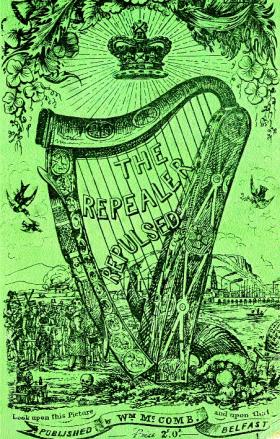 On 16–19 January 1841, as the Whig government of Lord Melbourne tottered towards collapse, Daniel O’Connell visited Belfast to address a Repeal meeting. He was accompanied by the Protestant Repealers Robert Dillon Browne (MP for Mayo) and Thomas Steele (the ‘Head Pacificator’), and by his son-in-law Charles O’Connell (formerly MP for Kerry). O’Connell came at the behest of Charles Gavan Duffy, editor of a Belfast Catholic paper (the Vindicator) which had aggressively charged the Presbyterian liberal unionism represented by the Northern Whig newspaper with paying insufficient regard to Belfast Catholic interests.
On 16–19 January 1841, as the Whig government of Lord Melbourne tottered towards collapse, Daniel O’Connell visited Belfast to address a Repeal meeting. He was accompanied by the Protestant Repealers Robert Dillon Browne (MP for Mayo) and Thomas Steele (the ‘Head Pacificator’), and by his son-in-law Charles O’Connell (formerly MP for Kerry). O’Connell came at the behest of Charles Gavan Duffy, editor of a Belfast Catholic paper (the Vindicator) which had aggressively charged the Presbyterian liberal unionism represented by the Northern Whig newspaper with paying insufficient regard to Belfast Catholic interests.
Opposition of Henry Cooke
Unfortunately for O’Connell, it was not only Repealers who sought to persuade Northern Whigs that they must abandon their centre position and seek allies. Henry Cooke, the dominant figure in the Presbyterian general assembly, believed that Presbyterians should join Anglican Tories in a pan-Protestant alliance. His influence rested on his oratorical prowess and his willingness to meet opponents in debate under the most unfavourable circumstances; on 5 January 1841 he publicly challenged O’Connell to debate with him in Belfast.
O’Connell refused the challenge on the grounds that Cooke was too insignificant to deserve notice. (The Vindicator also pointed out that such a meeting would probably degenerate into a sectarian riot.) Cooke’s supporters denounced O’Connell’s visit as an invasion of Ulster: hostile crowds gathered in Ulster towns along the Dublin–Belfast route, and O’Connell was obliged to abandon plans for high-profile receptions along his route and to travel two days early disguised as a well-known Dublin ventriloquist. (His supporters hailed this stratagem as a glorious triumph while opponents mocked it as a humiliating display of cowardice.) Plans for O’Connell to address his supporters in a city centre building were abandoned when it became clear that many tickets had gone to Cooke supporters; instead, the Liberator spoke from the roof of Kean’s Hotel (on the corner of Donegall Square and what is now Royal Avenue, in front of the old White Linen Hall on the site of the present City Hall), with his words rendered inaudible by rival mobs cheering for him and for Cooke.
A Repeal soirée that evening was interrupted when rioters threw stones through the windows, going on to attack the Vindicator offices and other Catholic-owned premises. (Cooke was accused of encouraging the rioters; his supporters claimed that some Protestant houses had also been attacked by Catholic rioters.) O’Connell had to request a police escort for his journey on 19 January from Belfast to Donaghadee, where he caught the ferry to Scotland en route to Westminster.
Cooke’s supporters celebrated with a rally in Belfast on 21 January, chaired by the marquess of Downshire (who presided over the famous 1836 Hillsborough meeting where Cooke pronounced ‘the banns of union’ between Presbyterianism and the Church of Ireland against the Catholic threat) and addressed by the Conservative MP for Belfast, Emerson Tennent, and by Downshire’s heir, Lord Hillsborough. This was followed by a banquet on 23 January. On both occasions Cooke delivered orations declaring that Protestants would not be safe from persecution under Repeal and attacking O’Connell’s alleged beggary, lying and general unscrupulousness with the skill of a stand-up comedian.
William McComb’s The Repealer Repulsed
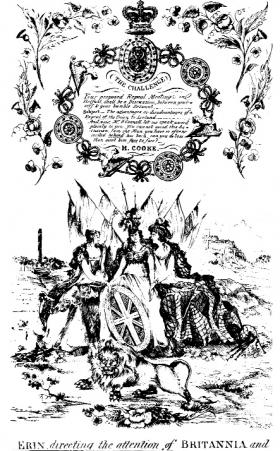 The standard account of these events was compiled by the Belfast Presbyterian bookseller/publisher William McComb, and published as The Repealer Repulsed. (Its price of two shillings suggests an élite audience.) McComb (1793–1873), who began his career by setting up a Sunday school to oppose the ideas of Tom Paine, had been brought into alliance with Anglican Evangelicals while working as a Kildare Place Society schoolmaster. His verse, in Standard English (he was known as ‘the laureate of the Presbyterian Church’), his role in disseminating Cooke-inspired Presbyterian literature, including the popular McComb’s Presbyterian Almanac (1840–84), and his involvement with the first overseas mission sent out by the Irish Presbyterian Church reflect the growing standing and self-confidence of Ulster Presbyterianism. (The Repealer Repulsed contains numerous literary citations and parodies, and begins by presenting O’Connell’s ‘invasion’ and the activities of successive Catholic bishops of Down and Connor as part of a papally directed offensive against Ulster Protestantism.) The book combines a hostile account of O’Connell’s visit and meeting with a fulsome report of the speeches delivered at the Conservative meeting, a collection of anti-O’Connell verses from various newspapers, and various dialect ‘letters’ and ‘conversations’ satirising O’Connell for beggary, lies, and reliance on a ‘tail’ of disreputable followers. It has been described as a founding document of Ulster Unionism.
The standard account of these events was compiled by the Belfast Presbyterian bookseller/publisher William McComb, and published as The Repealer Repulsed. (Its price of two shillings suggests an élite audience.) McComb (1793–1873), who began his career by setting up a Sunday school to oppose the ideas of Tom Paine, had been brought into alliance with Anglican Evangelicals while working as a Kildare Place Society schoolmaster. His verse, in Standard English (he was known as ‘the laureate of the Presbyterian Church’), his role in disseminating Cooke-inspired Presbyterian literature, including the popular McComb’s Presbyterian Almanac (1840–84), and his involvement with the first overseas mission sent out by the Irish Presbyterian Church reflect the growing standing and self-confidence of Ulster Presbyterianism. (The Repealer Repulsed contains numerous literary citations and parodies, and begins by presenting O’Connell’s ‘invasion’ and the activities of successive Catholic bishops of Down and Connor as part of a papally directed offensive against Ulster Protestantism.) The book combines a hostile account of O’Connell’s visit and meeting with a fulsome report of the speeches delivered at the Conservative meeting, a collection of anti-O’Connell verses from various newspapers, and various dialect ‘letters’ and ‘conversations’ satirising O’Connell for beggary, lies, and reliance on a ‘tail’ of disreputable followers. It has been described as a founding document of Ulster Unionism.
The Repealer Repulsed contains line drawings, apparently by McComb himself, inspired by the anti-O’Connell cartoons of John Doyle or ‘HB’ (see Peter Gray’s ‘“Hints and Hits”: Irish caricature and the trial of Daniel O’Connell, 1843–4’, in HI 12.4, Winter 2005). These are of interest as a relatively rare example of visual propaganda from the O’Connell period produced by an Ulster unionist source (as distinct from the better-known London caricatures of O’Connell).
Heaven or hell imagery
The cover illustration of the original edition (p. 43) provides an early example of the adaptation of Protestant ‘two ways’ imagery (where the viewer is asked to choose between two paths, one leading to heaven and the other to hell) for unionist political purposes. (Similar adaptations were made as late as the 1950s, when Unionist election posters exhorted viewers to choose between de Valera—seated on a wall beside a road leading to a mud-walled cabin—and a dynamic-looking Brookeborough pointing down the highway to a prosperous-looking town full of thriving factories.) The picture is divided by a huge harp (whose decorations include Union Jack roundels and images of the Scottish lion rampant). In the middle distance, to one side of the harp, O’Connell addresses a ragged and menacing-looking crowd, several of whom are waving clubs and may even be fighting with one another. With one hand O’Connell gestures to his audience; with the other he surreptitiously passes a hat (for money-collecting purposes) to a barefoot boy. The foreground is occupied by a drink-seller and skull and crossbones. (Cooke declared that under Repeal, ‘Were the agitator once elevated on the shoulders of ascendant Popery, the “death’s head and cross bones” would be the emblems of his great seal’.) In the background stick figures appear to be attacking and pursuing one another and a house burns. Above the crowd a hawk chases a small bird.
In the middle distance behind the harp, and extending over towards the other side of the picture, is a representation of Belfast (identifiable by Cavehill, the old long bridge over the Lagan, and the tower of the White Linen Hall in Donegall Square). Several smoking factory chimneys are visible, and the masts of many ships can be seen on the far side of the bridge. (McComb is clearly illustrating Cooke’s celebrated apostrophe on the economic blessings the Union had brought to Belfast, which spoke of the genii of Protestantism, Liberty and Industry presiding over Belfast from Cavehill and described ‘the masted grove within our harbour . . . our mighty warehouses teeming with the wealth of every climate . . . our giant manufactures [factories] lifting themselves on every side . . . Look at Belfast, and be a Repealer—if you can’.) From the factory 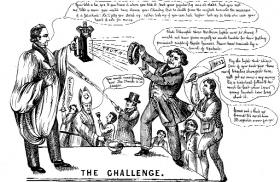 chimneys rises a horn of plenty, whose mouth pours forth the fruits of industry in the foreground; beside it at the edge of the picture is a busy beehive, symbolising fruitful labour. Above Belfast hovers the dove of peace, carrying an olive branch. At the top of the picture the imperial crown of Britain floats above the harp, emitting rays of light; the whole scene is crowned with a ‘Scots-Irish’ wreath of mingled shamrocks and thistles, containing a Union Jack.
chimneys rises a horn of plenty, whose mouth pours forth the fruits of industry in the foreground; beside it at the edge of the picture is a busy beehive, symbolising fruitful labour. Above Belfast hovers the dove of peace, carrying an olive branch. At the top of the picture the imperial crown of Britain floats above the harp, emitting rays of light; the whole scene is crowned with a ‘Scots-Irish’ wreath of mingled shamrocks and thistles, containing a Union Jack.
In his recent book on nineteenth-century political cartoons, Michael de Nie states that, although depictions of female personifications of Hibernia with Britannia are commonplace, he has yet to come across a ‘three kingdoms’ example incorporating Caledonia. Caledonia’s inclusion here (p. 44) reflects the Presbyterian sense of shared identity with Scotland; she is identified by her tartan mantle and plumed Highland bonnet. Bagpipes lie at her feet (matching Hibernia’s harp and wolfhound) and the Irish round tower (possibly Glendalough) is balanced by a view of Edinburgh Castle, with the royal standard flying from the turret and Arthur’s Seat in the background. Both Caledonia and Hibernia are presented as strong, upright figures with elaborately coifed hair and respectable, albeit exotic and somewhat low-cut, dresses. Their physical contact with Britannia (Caledonia holds one of Britannia’s hands and has her other arm round her sister’s neck, while Hibernia indicates the challenge with one hand; her other may have originally been intended to hold Britannia’s hand but now touches the shield resting on Britannia’s knee) takes the form of gestures of sisterly sympathy and solidarity rather than abject appeals for relief. Nevertheless, although Hibernia takes the active role here, Britannia is clearly the senior partner, indicated by her central and slightly higher position, her traditional helmet and shield, and the military banners which tower menacingly behind her. Similarly, although shamrocks and thistles are placed on the ground in front of the two lesser nations, the central and foremost position is occupied by the English rose and a menacing British lion. The text of Cooke’s challenge floats in mid-air, surrounded by the insignia of the Order of St Patrick, including the ‘Brian Boru’ harp and a shamrock with the motto QUIS SEPARABIT; on each side shamrocks may be seen mingled with Scottish thistles and English roses.
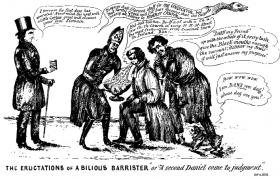 A badly aimed squirt of holy water
A badly aimed squirt of holy water
In the first drawing in the text itself, ‘The Challenge’ (p. 45, bottom), a tall and imposing Cooke (dressed in full clerical robes and collar with ‘Geneva bands’) holds up a lamp surmounted by the British crown, which emits the light of truth upon a staggering O’Connell (noticeably shorter than Cooke). One of O’Connell’s associates attempts to extinguish the light with a badly aimed squirt of holy water. The Catholic Bishop Denvir of Down and Connor, attacked in The Repealer Repulsed for supporting the Vindicator, is accompanied by two acolytes with bell and candle (presumably as adjuncts to the pronouncement of a solemn curse upon Cooke). He has the crook of his crosier around O’Connell’s ankle and pulls him forward like a stage-manager encouraging a nervous actor. O’Connell’s begging-bowl is visible on the platform beneath the shaft of the crosier. The elderly former Belfast United Irishman John Sinclair (who chaired O’Connell’s meeting) threatens to withdraw his subscription from O’Connell and comments that Cooke would have been easily beaten ‘when I was young’ (i.e. the United Irishmen would have put him down by force: Repealer repeatedly accuses O’Connell of wishing to resume the work of the United Irishmen, and equates his visit to Belfast with those of Wolfe Tone in 1791 and 1792). Tom Steele, recklessly clinging to O’Connell’s coat-tails and waving a butcher’s cleaver (the Hercules Street butchers stewarded O’Connellite meetings), offers to fight on his master’s behalf.
‘The Eructations of a Bilious Barrister’
‘The Eructations of a Bilious Barrister or A second Daniel come to judgment’ (p. 45, top) attacks a minor Whig magistrate. John Gibson, assistant-barrister for Antrim, whose statement that Belfast had the highest crime rates in Ireland had previously been cited by O’Connell as a defence against accusations of Irish Catholic lawlessness, had 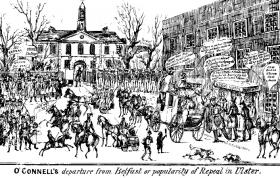 opened quarter sessions on 12 January 1841 with a defence of his former remarks, describing O’Connell as ‘a great national leader’ and Cooke as ‘a ferocious divine . . . the sanctimonious belligerent’. Here Gibson (seated in barrister’s wig and gown) vomits up his insults to Belfast to be collected by Denvir (whose mitre is here decorated with the papal keys of St Peter) for reproduction in the Vindicator. Denvir, whose speech-balloon transforms itself into the head of a serpent, shamefacedly admits that the Belfast criminals mentioned by Gibson ‘nearly all belong to Mother Church’. In a particularly offensive touch, the vessel that collects the vomit is depicted as a chalice or ciborium (from which consecrated Hosts are distributed during Mass). O’Connell (wearing his barrister’s gown and with a clearly visible cloven hoof) encourages Gibson’s outpourings, which he will use against the ‘blackmouths’ (a derogatory name for Presbyterians). Beside his ankle a small dog with a man’s head boasts of his doglike subservience to O’Connell; he is identified as ‘Charley’ (probably Gavan Duffy; possibly Charles O’Connell, Daniel’s son-in-law, who accompanied him to Belfast). Cooke, in lay dress, describes his challenge as an emetic aimed at cleansing Gibson’s ‘foul stomach’ and predicts that his reply to O’Connell, combined with the recent Conservative victory in the Carlow by-election (represented visually as a bottle of ‘Carlow Anti-Bilious Pills’), will complete the cure.
opened quarter sessions on 12 January 1841 with a defence of his former remarks, describing O’Connell as ‘a great national leader’ and Cooke as ‘a ferocious divine . . . the sanctimonious belligerent’. Here Gibson (seated in barrister’s wig and gown) vomits up his insults to Belfast to be collected by Denvir (whose mitre is here decorated with the papal keys of St Peter) for reproduction in the Vindicator. Denvir, whose speech-balloon transforms itself into the head of a serpent, shamefacedly admits that the Belfast criminals mentioned by Gibson ‘nearly all belong to Mother Church’. In a particularly offensive touch, the vessel that collects the vomit is depicted as a chalice or ciborium (from which consecrated Hosts are distributed during Mass). O’Connell (wearing his barrister’s gown and with a clearly visible cloven hoof) encourages Gibson’s outpourings, which he will use against the ‘blackmouths’ (a derogatory name for Presbyterians). Beside his ankle a small dog with a man’s head boasts of his doglike subservience to O’Connell; he is identified as ‘Charley’ (probably Gavan Duffy; possibly Charles O’Connell, Daniel’s son-in-law, who accompanied him to Belfast). Cooke, in lay dress, describes his challenge as an emetic aimed at cleansing Gibson’s ‘foul stomach’ and predicts that his reply to O’Connell, combined with the recent Conservative victory in the Carlow by-election (represented visually as a bottle of ‘Carlow Anti-Bilious Pills’), will complete the cure.
‘Who cares about the bloody blackguards of Sandy Row?’
‘O’Connell’s Departure from Belfast or Popularity of Repeal in Ulster’ (left) emphasises the numerous military escorts required to protect him en route to Donaghadee. O’Connell whines fearfully, ‘Cooke has done for us . . . Surely my life will not be taken’, while a sympathiser commiserates ‘’Tis all up with Repeal now’. At the front of the coach Steele and Browne compare security precautions, while a blunderbuss-wielding Charles O’Connell defiantly proclaims ‘Who cares about the bloody blackguards of Sandy Row?’ (Cooke later taunted Charles—whom he mistook for a son of O’Connell—for his subsequent description of the coach’s dangerous passage through Sandy Row, 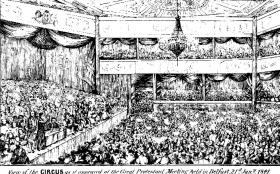 which in fact it had never entered.) A treasure chest marked RENT is securely fastened to the top of the stagecoach. Bishop Denvir, standing under the hotel canopy, pronounces a nonsensical Latin blessing.
which in fact it had never entered.) A treasure chest marked RENT is securely fastened to the top of the stagecoach. Bishop Denvir, standing under the hotel canopy, pronounces a nonsensical Latin blessing.
In the left foreground a large dog with its tail up pursues a cur, which flees with its tail ignominiously between its legs. To the right, a ragged crowd join the general derision; one is holding up a placard labelled ‘Challenge’ and a bagpiper plays the tune ‘Fly not Yet’. In front of the Linen Hall railings a more respectably dressed crowd shout ‘Union for ever’; trees in the Linen Hall grounds bear placards proclaiming ‘No repeal’ and ‘Cooke’s Challenge’, and further along an intrepid Cooke supporter, mounted in a tree above the heads of O’Connell’s military escort, waves a banner marked ‘The Challenge’.
In a ‘View of the CIRCUS as it appeared at the Great Protestant Meeting held in Belfast, 21st Jany., 1841’ (left), Cooke stands beside the table, addressing the crowd; Downshire is visible in a high chair behind the table, and John Bates is seated at the table with pen and ink. The features of other members of the platform party are clearly visible; the man with arm raised behind Cooke may be Emerson Tennent or Hillsborough.
‘Tongue of dog, and snout of pig/Curl of Dan’s official wig’
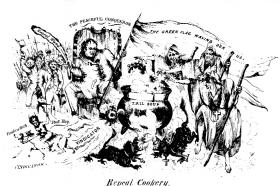 The last illustration (above)—apart from a small ‘Tail Piece’ where O’Connell is symbolised by a long-tailed monkey (below)—illustrates a travesty of the witches’ cauldron scene from Macbeth, supposedly set in ‘a dark room in the Vindicator office’. O’Connell as Hecate, goddess of witches, presides from an ornately carved throne; although labelled ‘The Peaceful Conqueror’, he holds a bludgeon marked ‘Repeal Wand’ (wands were given to Repeal wardens for use in crowd control) in one hand. The other hand holds a spear-pointed flagstaff with a line from one of Moore’s more martial melodies (whose use by O’Connell was cited by Cooke as proof of treasonable intent). O’Connell is cheered by a menacing crowd of ‘gulls’ (dupes), as Cooke described them; they bristle with pikes and pitchforks. The three witches are dressed in the habits of mendicant friars, barefoot, with walking-staffs in their hands, cowls over their heads, and large rosaries worn as necklaces. The text informs us that the ‘Tail Soup’ they brew includes among its ingredients water from holy wells,
The last illustration (above)—apart from a small ‘Tail Piece’ where O’Connell is symbolised by a long-tailed monkey (below)—illustrates a travesty of the witches’ cauldron scene from Macbeth, supposedly set in ‘a dark room in the Vindicator office’. O’Connell as Hecate, goddess of witches, presides from an ornately carved throne; although labelled ‘The Peaceful Conqueror’, he holds a bludgeon marked ‘Repeal Wand’ (wands were given to Repeal wardens for use in crowd control) in one hand. The other hand holds a spear-pointed flagstaff with a line from one of Moore’s more martial melodies (whose use by O’Connell was cited by Cooke as proof of treasonable intent). O’Connell is cheered by a menacing crowd of ‘gulls’ (dupes), as Cooke described them; they bristle with pikes and pitchforks. The three witches are dressed in the habits of mendicant friars, barefoot, with walking-staffs in their hands, cowls over their heads, and large rosaries worn as necklaces. The text informs us that the ‘Tail Soup’ they brew includes among its ingredients water from holy wells,
‘Cinders three from Scullabogue
Hobnails nine of Whiteboy brogue
Tongue of dog, and snout of pig
Curl of Dan’s official wig’.
The pot is heated by the fiery breath of two hellhounds wearing pectoral crosses; one wears a bishop’s mitre with the papal crossed keys. After being cooled with ‘heretic’s blood’, the cauldron’s contents (including poisonous serpents) are released through a stopcock shaped like a dragon’s head; they fuel ‘the Vindicator’s post boy’ (a demon with the staff and winged sandals of the messenger-god Mercury) as he rides on a she-wolf with cloven hooves to disseminate lying accounts of O’Connell’s Belfast ‘triumph’.
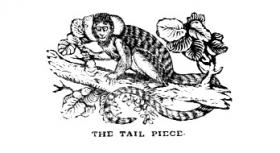 McComb’s career has so far received little attention, despite his importance as a disseminator of Presbyterian orthodoxy and political conservatism. His illustrations to The Repealer Repulsed provide significant insights into the Cookeite version of political Protestantism, its view of O’Connell, and its adaptation of Protestant iconography and the visual language of metropolitan Unionism to serve its own objectives.
McComb’s career has so far received little attention, despite his importance as a disseminator of Presbyterian orthodoxy and political conservatism. His illustrations to The Repealer Repulsed provide significant insights into the Cookeite version of political Protestantism, its view of O’Connell, and its adaptation of Protestant iconography and the visual language of metropolitan Unionism to serve its own objectives.
Patrick Maume is a researcher for the Dictionary of Irish Biography.
Further reading:
M. de Nie, The eternal Paddy: Irish identity and the British press, 1798–1882 (Wisconsin, 2004).
F. Holmes, Henry Cooke (Belfast, 1981).
B. Loftus, Mirrors: Orange and Green (Belfast, 1994).
W. McComb, The Repealer Repulsed (Belfast, 1841; Dublin, 2003).
















